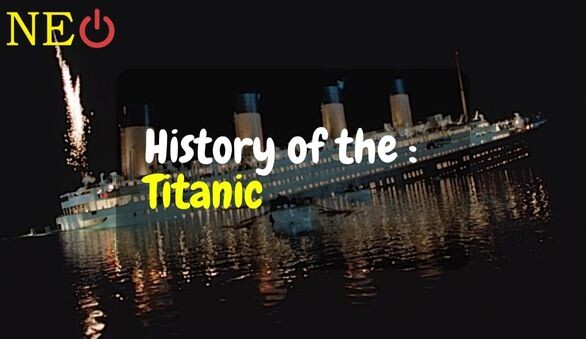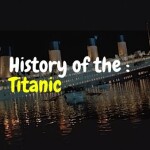Interests in History, Culture, and Iconic Figures in the United States and Abroad
The R.M.S. Titanic is perhaps the most well-known shipwreck in modern popular culture. Titanic was a British-registered White Star line ship owned by a US company in which famed American financier John Pierpont "JP" Morgan was a major stockholder. Harland & Wolff built the Titanic in Belfast, Northern Ireland for the transatlantic voyage between Southampton, England and New York City. It was the largest and most luxurious passenger ship in the world at the time, and it was said to be unsinkable. Launched on May 31, 1911, Titanic sailed from Southampton with 2,240 passengers and crew on board on April 10, 1912. Titanic sank to the bottom of the ocean on April 15, 1912, after colliding with an iceberg and killing over 1,500 passengers and crew.
Outside of the major hull portions, some salvage has occurred, but the majority of the ship remains in its final resting place, 12,000 feet below sea level and over 350 nautical miles off the coast of Newfoundland, Canada. Its famous story of disaster and human drama has been and continues to be told in a plethora of books, =articles, and films. Titanic was recognised by the United States Congress for its national and international significance, and it has become a cultural icon in many ways.A number of memorials have also been established around the world as a result of the disaster. There are major memorials in Washington D.C.offsite link and New Yorkoffsite link in the United States; the Widener Library offsite link at Harvard University is another major memorial honouring Henry Elkins Widener, a shipwreck casualty.
Investigation and Development of Navigational Safety Measures
The Titanic's sinking was one of history's deadliest peacetime maritime disasters, and it quickly became a catalyst for change. Hearings on the incident were held by the US Congress, which led to the creation of a report and steps to increase navigational safety. In the United Kingdom, similar investigations were conducted.The international community quickly came together to establish global maritime standards and regulations to promote navigation safety, the most important of which was the Convention for the Safety of Life at Sea (SOLAS), widely regarded as the most important of all international agreements on merchant ship safety.
The US Coast and Geodetic Survey (USCGS, a predecessor agency of NOAA) developed radio acoustic ranging navigation in 1924 in response to the Titanic's sinking. Sonar was invented as a result of the transmission and reception of sound waves. The power of sonar as an underwater search tool and a method of measuring ocean depths was recognised by the USCGS and hydrographic offices around the world.Today, accurate and precise nautical charts are created using data collected by survey vessels outfitted with echo-sounding technology.
The Titanic Wreck Site is Discovered by a Team of Explorers from the United States and France
The Titanic wreck was found on September 1, 1985, by a joint French-American expedition headed by Jean-Louis Michel of the French Research Institute for Exploration of the Sea (IFREMER) and Dr. Robert Ballard of the Woods Hole Oceanographic Institution. The wreck, which was found in international waters at a depth of 12,500 feet (3,800 metres), was located around 350 nautical miles (nm) off the Canadian coast of Newfoundland. Dr. Ballard gave a testimony before the US Congress soon after the disaster was discovered to support the passage of legislation designating it as a marine memorial. A plaque was erected on the R.M.S. Titanic in July 1986, commemorating the wreck's discovery the year before and urging its preservation in honour of those who perished on board. A US company collaborating with IFREMER went back to the wreck in 1987 and started bringing artefacts from the artefact field.
The US Congress takes action to safeguard the Titanic through international cooperation
Congress passed the R.M.S. Titanic Maritime Memorial Act of 1986 (1986 Act), which instructed the US to (1) start negotiating an international agreement to launch multinational conservation efforts; and (2) develop guidelines for exploration, research, and salvage The shipwreck was identified by Congress as having significant historical and cultural value. On behalf of those who perished in the sad sinking, it also requests that the location be acknowledged as a global marine memorial.
The R.M.S. Titanic's National and Global Importance
The R.M.S. The Titanic shipwreck is incredibly significant on a national and international level. One of the crown gems of the marine heritage of the globe.
Nationwide Importance
The Titanic provides a concrete link to American maritime history because it was an American-owned, British-registered ship. The British White Star Line, a division of the American-controlled International Mercantile Marine Co. of New Jersey, whose principal shareholder was the industrial billionaire J.P. Morgan, owned and ran the ship. The Titanic, which was discovered in 1985 by American oceanographer Robert Ballard, a group from the Woods Hole Oceanographic Institution, and their international collaborators, continues to have a significant academic impact on the fields of marine science and American maritime history. The Archaeological Resources Protection Act defines Titanic, which celebrated its 100th birthday on May 31, 2010, as a "archaeological resource site". Scientific knowledge of the process of underwater archaeological preservation and bio-deterioration is being advanced by artefacts and data found at the wreck site.
Legislators, historians, filmmakers, and ocean enthusiasts all throughout the world have been influenced by Titanic in their creative endeavours. It has been a storyline point in numerous books, essays, films, and documentaries, including the Academy Award-winning James Cameron blockbuster Titanic.These serve as evidence of the shipwreck's remarkable significance in both American history and popular culture. The ship's historical value as the ultimate tribute to those whose lives were lost in her sinking, however, outweighs its significance as a cultural icon. 119 of the 306 Americans on board the Titanic never received rescue. The survivors, many of whom had lost relatives and friends in the catastrophe, arrived back in the country. Lillian Asplund, the final American Titanic survivor still alive, passed away in Massachusetts in 2006 at the age of 99. She lost her father, three brothers, including her twin brother Carl, who was five years old, and all of them on the Titanic when she was five. Immigrants from abroad who were travelling to the United States were among the Titanic's other passengers. A declaration of intent to become a citizen of the United States completed by a passenger who did not survive the sinking but whose well-preserved luggage was retrieved was a moving and significant artefact found at the disaster site. This object serves as a reminder that the majority of these people perished, taking the American ideal with them.
Today, the R.M.S. Titanic disaster serves as a symbol of the hardship and difficulty that many immigrants went through at the time as they set out for the other side of the Atlantic Ocean in search of a better life and a brighter future for themselves and their children. Millions of immigrants who arrived in the United States on the same transatlantic journey as the R.M.S. Titanic left behind them, and their lives today are the living legacy of those immigrants. America's history is reflected in the Titanic's tale.
International Significance
Because of the R.M.S. Titanic disaster, a significant portion of existing international law governing marine shipping and safety was created. Following its sinking on April 14–15, 1912, the Titanic generated a law-making frenzy that resonated throughout the whole world. In 1914, the first International Convention for the Safety of Life at Sea (SOLAS) was adopted as a result of this fervour. Although SOLAS has undergone numerous revisions, it remains the most significant treaty addressing marine safety. The International Maritime Organisation (IMO)offsite link was founded to address maritime safety, and its origins may be traced back to SOLAS and the Titanic. When commemorating its 35th World Maritime Day on September 27, 2012offsite link, the IMO also remembered the 100th anniversary of the tragic Titanic sinking, which served as the impetus for its founding.

Related posts
The $1 Trillion Question: Does Tesla Need Elon Musk More Than Ever?
11 Nov, 2025 18 mins read 250 views
Adventure Photography Tips – Capture Epic Shots While Hiking, Trekking, or Camping
02 Sep, 2025 9 mins read 1,487 views
Adventure photography isn’t just about snapping pictures—it’s about telling the story of your journey. Whether hiking, trekking, or camping, capture epic shots by traveling light, using natural light, experimenting with angles, and embracing weather changes. Stay safe, focus on composition, and let your camera reflect the true spirit of your adventure.
Categories
- Tips (158)
- Global News (113)
- Business (97)
- Lifestyle (80)
- Travel (80)
Lastest Post
L
Your experience on this site will be improved by allowing cookies Cookie Policy








